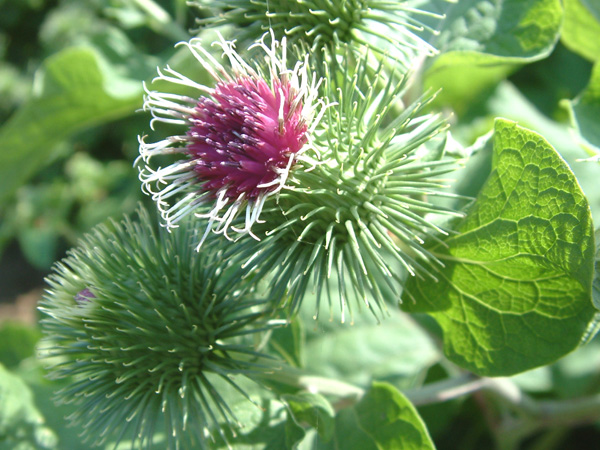Medicinally burdock mainly refers to the dried ripe fruits of Arctium lappa L., which is a member in the family Asteraceae. Hence, other names of burdock include Great Burdock Fruit Seed, Arctium Fruit, Arctium Fructus Arctii, Fructus Arctii Lappae, Arctium lappa fruit, common burdock, etc. In China it is mainly produced in the Northeast, Zhejiang, Sichuan, Hubei, Hebei, Henan, and Shaanxi. People usually collect the ripe infructescence in autumn for medicinal purpose. After that, it still needs to dry them in the sun, gather the fruits, remove the impurities, and dry them once again. It is used raw or fried (crushed) in decoction. And other popular products include burdock tea, tincture, extract, essential oil, folate lotion, etc.
Burdock plants are a biennial herb, which is 1 to 1.5 meters in height and multi-branched in upper part. Radical leaves cluster and cauline leaves are alternate; large leaves are with long petiole and longitudinal grooves on the surface; leaf blade is wide oval or heart-shaped. Fasciculate capitulum is at top of branch and arranged in corymbose, which is 2 to 4 cm in diameter; peduncle is pubescent, from 3 to 7cm in length, and with shallow grooves; involucre is sphere, consisting of a majority of imbricate bracts; corolla has 5-lobed apex and the lobes are in the shape of long, narrow triangle; stamens are 5; ovary is oval and inferior. Achenes are taupe, long, obovate and slightly curved. Bloom time is from June to July and fruiting time is from July to August.
BURDOCK BENEFITS
As mentioned above, medicinally the burdock root, leaf and seed are quite different. So, it is necessary to distinguish them here. When it comes to burdock, it usually means the seed since it is the main medicinal part in traditional Chinese medicine. But under less stringent conditions, the word of burdock can refer to any of them.
Burdock root is with edible and medicinal properties. But it is mostly eaten as a root vegetable. And even though used as medicine, it is usually in the form of dietary therapy. It contains a natural dietary fiber called inulin, which can be used to promote bowel movements, help defecation, lower cholesterol, and reduce the accumulation of toxins and waste in the body. As a result, it is able to prevent and treat stroke, Gastric Cancer, and uterine cancer. Western medicine believes that it increases secretion of urine, removes food retention, eliminates phlegm, checks diarrhea, etc. That's why it is recommended using in the food therapy for Constipation, high blood pressure, and High Cholesterol.
Burdock leaves are also edible too. Using it as vegetable can treat intermittent headache, dysphoria with smothery sensation, acute mastitis and other illnesses. And long-term use can help healthy person moisturize the skin, lose weight, and prolong life.

Burdock
Burdock seed has many health benefits. Here are its top 3 traditional medicinal uses. First and foremost, it cures measles since it is a detoxifying plant itself. Besides, it is good at treating pharyngitis as it can moisten lung for removing phlegm. Last but not least, as one of common Chinese herb for healing wounds and swelling, its powder can help heal wounds quickly. In addition, arctigenin was first found with the ability of effectively improving memory impairment in mice, which was completed and published on Journal of Neuroscience online by the 3 research groups of Shen Xu, Hu Lihong and Jiang Hualiang in the name of Shanghai Institute of Materia Medica (1). Actually as early as 2011, the research team of Shen Xu and Hu Lihong has already found new evidence on the antifatigue action of arctigenin (2). This discover is really important since it means a lot to the patients suffering from Alzheimer's disease, which is a kind of progressive neurodegenerative process that mainly characterized as memory impairment.
SAMPLE BURDOCK RECIPES ON HERBAL REMEDIES
1. Wu Wei Xiao Du Yin from Yi Zong Jin Jian (Golden Mirror of Orthodox Medicine). This formula combines Pu Gong Yi (dandelion), burdock, Ju Hua (Chrysanthemum Morifolium), Zi Hua Di Ding (Herba Violae), and Zhi Bei Tian Kui Zi (semiaquilegia root) to cure furunculosis.
2. Yi Qiao San from Wen Bing Tiao Bian (Detailed Analysis of Warm Diseases). It is combined with Jin Yin Hua (honeysuckle flower), Lian Qiao (Forsythia), Jing Jie (Schizonepeta), Jie Geng (Balloon Flower Root), etc. to treat wind-heat cold, the beginning of febrile disease, fever, sore throat, etc.
3. Zhu Ye Liu Bang Tang from Xian Xing Zhai Yi Xue Guang Bi Ji (Wide-ranging Notes from the First-awakened Studio). It is formulated with Bo He (mint herb), Cheng Liu (tamarix chinensis), Zhu Ye (Folium Bambusae), etc. to heal skin rash failing to appear.
4. Niu Bang Zi Tang from Wai Ke Zheng Zong (Orthodox Exogenous Illnesses). It is used together with honeysuckle, forsythia, Zhi Zi (Gardenia), Gua Lou (Trichosanthes Kirilowii), etc. to cure swelling painful mastitis.

![Diseases, Symptoms, tcm, [tcmwindow.com]](/uploadFile/adImg/2015/11/11/f5cbfcc0-4df5-4646-9b9a-f316651a0199.jpg)





